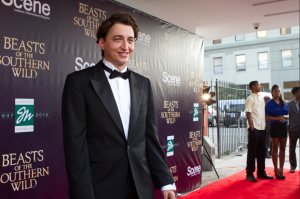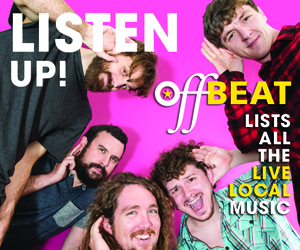Beasts of the Southern Wild took the cinematic world by storm in 2012, when the indie hit was nominated for four Academy Awards, including Best Picture of the Year. The film, set in a semi-mythical South Louisiana locale, was praised for its top-notch acting, its gorgeous cinematography and, among other things, its delightfully unconventional score.
That memorable soundtrack, which combined orchestral arrangements with elements of traditional cajun music, will roar back to life this Saturday, when director Benh Zeitlin teams up with Worldless Chorus Orchestra, the Lost Bayou Ramblers and conductor Ryan McAdams, for a live-scoring of the film at New Orleans’ historic Saenger Theatre.
Zeitlin, who co-composed the score along with Dan Romer, took a moment to talk to us about what’s in store for this Saturday, the logistical issues associated with an event like this and what’s next for his filmmaking collective Court 13.
This live-scoring at the Saenger Theatre sound likes a pretty interesting event. What inspired this?
Well, it’s funny. It was always a dream of mine, from when I started with short films, to play movies with live music. I’ve always been involved in writing music, coming from a music background. One of the frustrating things about being a filmmaker is that, once you’re finished making the movie, you stop being involved. It doesn’t need you anymore. So the idea of being able to do a score live, to make the film an actual live event that you perform at is great.
Basically, I’ve always wanted to do this and a music group approached me and said that they had figured out how to produce this type of event. It’s pretty complicated because you strip out the music from the sound mix, then leave the voices over it. Technically, it’s extremely complicated to do. But they figured it out, so they approached me saying that they wanted to use our film for one of their events. Obviously I jumped on the chance. I’ve done it a couple of times, but it is very exciting this time because I get to bring home something that hasn’t been done in New Orleans. It’s a real treat for me.
How did it go the first few times you did this?
The first time we did it was one of the two best screenings we’ve ever done of the film. We played it outdoors in [Brooklyn’s] Prospect Park and had between seven and nine thousand people outside. It was incredible. It’s so crazy, as a performer and as a filmmaker, to be beside the screen, watching people watch your movie. it’s something you never get to do, seeing them making out or crying or laughing. You get to experience the audience from a totally different perspective.
I think a lot of people who came had already seen the movie in regular theaters, but hearing a live orchestra perform it definitely felt like a different experience and kind of heightened the emotion of the film and made it new again. It’s been fantastic every time we’ve done it.
Whenever we play the movie in Louisiana, people understand it so much better and so all the things that you kind of miss when you don’t know the place come alive. So to be able to do the live-score on our home turf is going to be really special.
I’ve seen the kind of thing done once before with the film Birdman. Antonio Sanchez came and he played the live drumming score himself. He worked a lot of improvisation into it. Is that going to be the case with this or is it going to be more or less faithful to the original score ?
Less so, because it’s a full orchestra. You’re dealing with a conductor and a click track. We’re basically playing the score. I think we’re probably going to incorporate some surprises in the event. Also, having the Lost Bayou Ramblers on stage is one of the really cool things about the way that it comes off. You have this classical orchestra, but then you also have this real gritty Cajun band that fits into that. So you get some elements of improvisational playing but within the framework of a fairly traditional orchestral score. That gives it a certain life that is not necessarily improvisational but has a more spontaneous feel to it.
You co-composed the score for Beasts of the Southern Wild, which is kind of a rare move for a director. How did that fact come into play when you were actually shooting the film? Were you constantly aware of what the music was going to be as you were making the film?
I think I had ideas. Using music in your writing process and knowing the way the music is going to reframe a scene certainly helps. You direct from that place and that context, so a lot of scenes are really radically reframed by the music, which is always the intent.
The music serves as a broadcast station from Hushpuppy, the main character’s, head. You know you’re shooting scenes that, if you look at them without music, you’d think “Oh God, this poor little girl is about to blow herself up with fireworks.” That’s really scary, but knowing that the music is going to be giving her point of view on that scene, which is that it’s a glorious, spectacular moment of patriotism. You know that you’re going to have that dichotomy operating and it changes the way that you direct.
Where did you draw inspiration while composing the score?
I think when we started scoring we had the idea that the music was going to be very much derived from Cajun music. In a lot of those early iterations, we were taking chord structures and that instrumentation and bringing it to the film. But as we went on with it, we realized that it didn’t quite work because the music is from Hushpuppy’s point of view. It felt much less like music that a 5 or 6 year old would be listening to.
So as we got into it, we started thinking about the kind of music that was really in my head when I was 6 years old. You’d be eating a bowl of cereal and you’d be playing the Batman theme in your head, or you’d be walking down the street and Indiana Jones would be playing. Those sorts of things, where you believe that your life is this grand adventurer as a child and you hear those huge classic film scores.
So where we ended up is this hybrid, where we used a lot of the same chord structures and some of the instrumentation survived, but we also added these layers that sort of bring out a much more grand, cinematic, feeling to it. What we ended up with in the film is a hybrid between those two sources.
What do you and Court 13 have in the works?
We’ve been in development on my next film, which is hopefully going to be shot sometime next year. We’ve basically been working on that since we got off the whole Oscar tour. And we’re also doing this big initiative. We sort of made Beasts like a community art project that involved both a lot of artists that were in town, but also bakers and people that we met on the streets. Then also tons of Cajuns, boatmen, etc. It was a big, grand community.
We’ve actually turned our company into a non-profit whose goal is to support and nurture that type of artistic community so we can keep on making films in that way and engage the community in New Orleans. Right now we’re doing this big fundraiser to try to get a permanent home up Franklin Avenue. That’s been a big project for us, to create a permanent arts space for the Court 13 community in Louisiana. So that no matter what happens, we have a home here and a place to make things from.
Is there anything else you would like to add?
Yeah, actually. The other big project of the year, we have a festival called Always a Pleasure. It’s like a movies/music/art mayhem kind of experience. It’s going to be November 13th and 14th. We’re gearing up for that. We don’t have a specific location yet, but stay tuned to all the broadcast media. It’ll start come into shape. It’s about the most wild and fun time that I’ve had doing the festival, and we’re opening it up more this year and bringing lots of new people who haven’t experienced it before. So look out for that.





